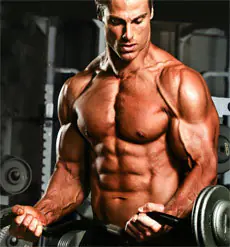All types of athleticism are based on strength training, the main specific means of which are strength (athletic) exercises. This article is a kind of classification of physical exercises available in the arsenal of a modern bodybuilder. Strength exercises (development tools) are physical exercises that most contribute to the development of muscle strength, as well as strengthening a person’s strength endurance. In this classification, we will study all the types, types and subtypes of exercises used by modern trainers, their wards, and all those who have decided to train on their own, no matter in the gym, on the street (workout training) or at home...
So, what are they? There are three types of exercises:
- I) Exercises with external (third-party) resistance (one of the most effective means of building strength). They are divided into the following types of exercises:
- a) with weights;
- b) with a partner;
- c) with the resistance of various types of elastic objects (shock absorbers, harnesses, expanders, etc.);
- d) with resistance from the external (environmental) environment (movement uphill, on loose sand, snow, water, as well as against the wind, against the current, etc.).
- II) Exercises with overcoming your own body weight. They are divided into:
- a) gymnastic strength training;
- b) athletics jumping.
- III) Isometric (static) exercises:
- a) exercises in the so-called passive tension (aimed at holding the load);
- b) exercises in active muscle tension. Isometric exercises are especially valuable for mental workers, students and other people who spend a long time in conditions of physical inactivity, hypokinesia and closed, limited space.
All physical exercises according to their type and nature are conventionally divided into 3 more main groups our classification:
- general impact - at least 2/3 of the total muscle volume is involved during work;
- regional – volume involved: from 1/3 to 2/3;
- local – less than 1/3 of all muscles work.
Press - a movement in the overcoming phase of which (i.e. when the muscles contract), the projectile moves away from the athlete: bench press, sitting press, standing press, leg press.
Traction - a movement in the overcoming phase of which the projectile moves towards the athlete: deadlift, vertical thrust, etc.
The methods of bodybuilding and athletic gymnastics require in-depth study of individual muscle groups to improve their quality, i.e., relief. In order to ensure this condition, muscles should work as isolated as possible from other muscle groups. In other words, the movement should be organized in such a way that it does not require the help of other muscle groups or that their help is minimal. The purpose of isolation exercises is, firstly, to ensure local (i.e., within the muscles being loaded) exhaustion and, secondly, to do this with minimal expenditure on the body’s overall energy reserve.
For isolated muscle work, dumbbells and exercise machines are mainly used.
Isolation exercises are performed in combination with basic exercises.
Self-isolating exercises can be used for health and rehabilitation purposes: restoring mobility in joints after injuries; persons with disabilities and poor health, since the load on the functional systems is not great and the choice of starting positions is wide.
- Expand the concept of “strength sports”.
- What sports are considered strength sports?
- Describe the types of strength exercises.
- Explain the purpose of basic and isolation exercises.



